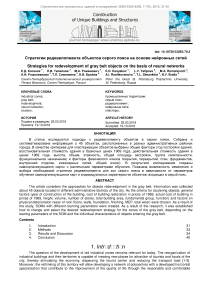Strategies for redevelopment of gray belt objects on the basis of neural networks
Автор: Kosyakov E.D., Talipova L.V., Romanovich M.A., Roshkovanova A.I., Simankina T.L., Braila N.V.
Журнал: Строительство уникальных зданий и сооружений @unistroy
Статья в выпуске: 7 (70), 2018 года.
Бесплатный доступ
The article considers the approaches for objects redevelopment in the gray belt. Information was collected about 45 objects located in different administrative districts of the city. As the criteria for clustering objects, general factors (year of construction of the building, сost of building restoration in prices of 1969, actual сost of building in prices of 1969, height, volume, number of stores, total building area, fundamental group, function) and factors on physical deterioration (wear of roof, floors, walls, foundation, finishing, MEP, total wear) were chosen. As a result of the study, SOMs with different learning parameters were created. As a result of the research, it was established how to change and select the desired redevelopment strategy for the zones of the gray belt, depending on the leaning parameters of the SOM and the individual characteristics of objects entering the gray belt.
Industrial zones, gray belt, redevelopment, neural networks, clusters
Короткий адрес: https://sciup.org/143168922
IDR: 143168922 | DOI: 10.18720/CUBS.70.3
Список литературы Strategies for redevelopment of gray belt objects on the basis of neural networks
- Хмелева Г.А. Современные модели городских агломераций // Вестник Самарского университета. Экономика и управление. 2015. № 8 (130). С. 163-168.
- Семикин П.В., Бацунова Т.П. Реконструкция промышленных здания с учетом конструктивных особенностей // Региональные архитектурно-художественные школы. 2012. №1. С. 143-147.
- Пирожков Н.С., Поваренкина М.С., Халилова Э.Ф., Шамарина А.А. Реконструкция фасадов промышленных объектов и объектов недвижимости городского значения // Вестник пермского национального исследовательского политехнического университета. Прикладная экология. Урбанистика. 2011. №3. С. 130-136.
- Молотков Г.С., Бубнюк Д.В. Обоснование реконструкции промышленного здания на основе расчёта показателя физического износа // Актуальные вопросы экономики и технологического развития отраслей народного хозяйства (Материалы региональной научно-практической конференции студентов, аспирантов, магистрантов и преподавателей). Майкоп.: 2016. С. 41-46.
- Менейлюк А.И., Лобакова Л.В. Алгоритм выбора эффективного решения по перепрофилированию промышленных зданий // Вестник приднепровской государственной академии строительства и архитектуры. 2016. №8 (221). С.35-41.
- Stieglitz M., Nefedov V. Refunctionalisation of industrial territories in Saint-Petersburg. Proceedings of the Institution of Civil Engineers: Urban Design and Planning. 2016. Vol.169. Pp.30-42.
- Borg R.F., Gambatese J., Haines Jr.K., Hendrickson C., Hinze J., Horvath A., Koehn E., Moritz S.L., Mass M., Haughney R.A. Rebuilding the World Trade Center. Practice Periodical on Structural Design and Construction. 2003. Vol. 8. No. 3. Pp. 137-145.
- Niederhagemann S. The reactivation of a historic shaft-building. Advances in Architecture. 2003. Vol. 15. Pp. 771-777.
- Valancius K., Motuziene V., Paulauskaite S. Redeveloping industrial buildings for residential use: Energy and thermal comfort aspects. Energy for Sustainable Development. 2015. Vol. 29. Pp. 38-46.
- Chan A., Cheung E., Wong I. Revitalizing industrial buildings in Hong Kong-A case review. Sustainable Cities and Society. 2015. Vol. 15. Pp. 57-63.
- Mesthrige J.W., Poon H.L. Assessing the impact of revitalized old industrial buildings on the value of surrounding properties. An empirical study. Facilities. 2015. Vol. 33. No. 3-4. Pp. 245-261.
- Amirante M.I., Frachino R., Frettoloso C. Fron the industrial building to the lab museum: fruition and environmental - energetic issues. Society, Integration, Education: Utopias and Dystopias in Landscape and Cultural Mosaic. 2013. Pp. 17-27.
- Ren L.P., Shih L., McKercher B. Revitalization of industrial buildings into hotels: Anatomy of a policy failure. International Journal of Hospitality Management. 2014. Vol. 42. Pp. 32-38.
- Коржиков Д.И., Лиханский Ю.И. Художественные приемы реконструкции промышленных зданий на примере работ Ж. Херцога и П. де Мерона // Новые идеи нового века: материалы международной научной конференции ФАД ТОГУ. 2011. Т. 1. С. 196-202.
- Chan A, Zhai B and Cheung E 2012 Evaluating the "revitalizing industrial buildings" scheme in Hong Kong. In Proceedings of 37th AUBEA International Conference 4-6th July 2012Theme: Construction Technology (Australia: Sydney) paper A51 Pp. 525-536.
- Постановление Правительства Санкт-Петербурга от 28.03.2012 N 275 «О Концепции социально-экономического развития Санкт-Петербурга до 2020 года»
- В Петербурге вырастут темпы освоения «серого пояса»: [Электронный ресурс]: Colliers International. [Б.м.], 2017. URL: http://www.colliers.com/ru-ru/stpetersburg/insights/company-news/2017/2017-11-08-redevopment-prospective (дата обращения: 30.10.2017).
- Талипова Л.В., Косяков Е.Д., Усова М.К., Семенов Д.А. Кластеры - основа формирования эффективной инновационной системы Санкт-Петербурга // Наука и инновации в XXI веке: актуальные вопросы, открытия и достижения. Сборник статей победителей IV Международной научно-практической конференции: в 3 ч. 2017. С.290-294.
- T. Kohonen, Self-Organizing Maps (Third Extended Edition), New York, 2001, 501 pages.
- ISBN: 3-540-67921-9
- Kohonen cards for clustering fund of the residential real-estate Popova O., Simankina T., Lukinov V. In the collection: MATEC Web of Conferences Editor V. Murgul. 2017. С. 01013.
- Попова О.Н. Метод календарного планирования ремонта жилых зданий на основе их структурного анализа: дисcертация канд. техн. наук. Санкт-Петербургский государсвтенный архитектрурно-строительный унивеситет. СПб, 2015.


